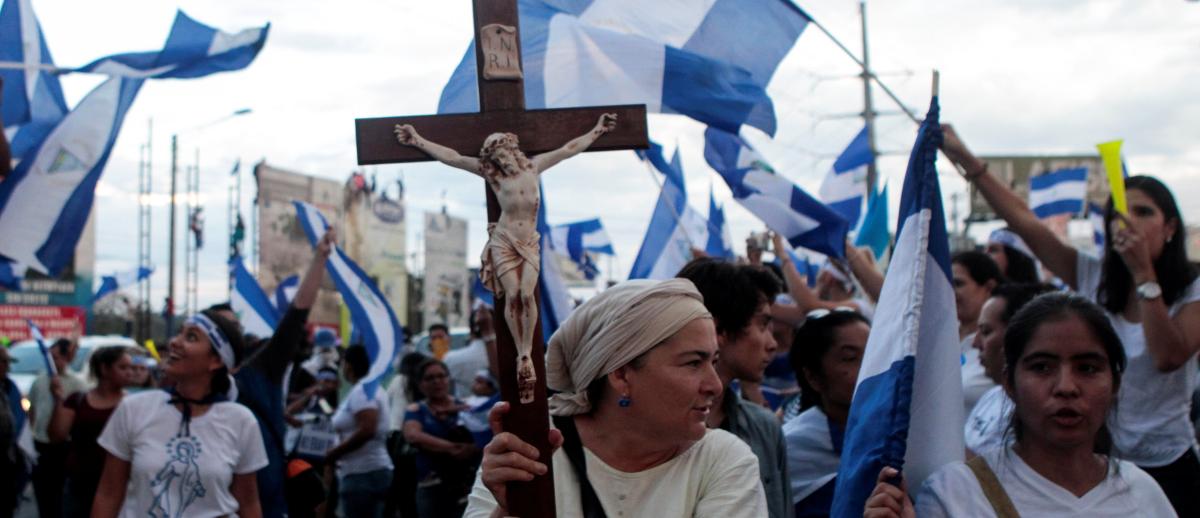The Failure of Latin America
archive


demonstration against Nicaraguan President Daniel Ortega's government in Managua, Nicaragua, May 15, 2018. (Photo credit: Oswaldo Rivas, Reuters)
The Failure of Latin America
The meltdown of Hugo Chávez’s project in Venezuela and the recent decisive defeat of the Workers Party in Brazil by an extreme right-wing candidate mark the end of a period of optimism about the fortunes of the Latin American left, a period sometimes designated as the Pink Tide. Both of these events represent failures of the Latin American left. What I want to think about here is a broader problem: the possibility of Latin America itself as a failed civilization.
Failed in relation to what? Failed in relation to China and India in particular, in the period that extends from the end of the Second World War to the present. If Latin America as a whole, especially Brazil, the Southern Cone, and Mexico, was in 1945 somewhat ahead of China and India, it is now clearly behind them in terms of demographic and economic growth on the one hand, and status or influence in the world on the other.
I mean civilization in the special sense that the late neoconservative political theorist Samuel Huntington gave this term in his famous essay “The Clash of Civilizations” (1994). Huntington thought of Latin America as a possible “civilization” in its own right, separate from North or Anglo America, marked by what he characterized as a more authoritarian-paternalistic ethos. But the Latin America nations were singly and collectively “torn countries”: would they define their future by an increasingly symbiotic and dependent relation to the United States, or could they develop their own hegemonic project or projects within the framework of globalization?
Huntington’s argument has been subjected to well-deserved criticism, but it remains pertinent in this sense: globalization brings into contact but thus also into conflict different forms of historicity previously separated by or subordinated to Western European historicity. There is a specifically Chinese form of historicity, which refers back to the empire of many thousands of years and which sees the rise of Western domination since the fifteenth century as a mere bubble of some five hundred years—the span of a dynasty—that is beginning to evaporate. There is a similar historicity in Indian nationalism, the sense of a millennial Hindu and/or Muslim imperial past returning after the interruption of British colonial rule, a past that absorbs much from that rule but is not limited to it.
Latin America, as a whole, does not have a similar historicity. Its relation to pre-Colombian civilizations has more the character of rupture than of continuity. Despite their near extinction due to colonialism, indigenous peoples in Latin America and North America do possess a similar historicity, but not Latin America itself or its individual nation-states. They are trapped within the historicity of colonialism and modern capitalism. That is why Latin America has become inconsequential or secondary in the post-Cold War world.
Latin American coloniality is different than Chinese or Indian coloniality. Neither China nor India suffered the genocide of large sections of their native populations, nor the imposition of Christianity in any extensive sense, nor the subordination of the indigenous languages. There was little or no mestizaje: economies were certainly distorted, but not radically transformed. As in the case of Africa and the Middle East too, with the exception of Israel and South Africa, the European populations residing in them could be removed without changing the characteristics of the underlying populations.
Latin America’s possibility cannot be separated from the formation and rise of the United States, which at almost every moment in its short imperial history has obstructed, interfered, stifled, bullied, bribed, threatened, and misdirected Latin America’s civilizational energy. Today in the United States we are deeply concerned with Russian meddling in our elections, but there was hardly a major election in Latin America during the Cold War that the United States did not meddle in directly or indirectly.
Latin America’s possibility cannot be separated from the formation and rise of the United States, which at almost every moment in its short imperial history has obstructed... and misdirected Latin America’s civilizational energy.
Trump’s fantasy of the Wall is only the latest chapter of a very long and sad story then. But it comes at a moment of what one can only describe as the waning of US power, the beginnings of its imperial decay. Trump, like the later Hapsburgs, is both a symptom and a cause of that decay. He is dismantling by his actions or by their effects at once the apparatus of the imperial state and the political and cultural hegemony of the United States. Even if Trump is decisively crippled or defeated politically—not a sure thing, by any means—US hegemony of the kind it enjoyed in the twentieth century is not recoverable. The emperor has been seen without his clothes.
All this should be good news for Latin America: in a zero-sum game equation Latin America will rise as the United States declines. Whether this happens or not, however, has to do with forces internal to Latin America.
It is difficult to imagine Latin America without considering Catholicism as part of its essential civilizational identity. But it may be that Catholicism has become more a hindrance than a stimulus to Latin America’s emergence as a civilization, more an aspect of its past (when it was part of the great Baroque civilization of the Spanish and Portuguese empires) than its future. If that is true, then Latin America’s future must involve conscious efforts towards a diminishment of the ideological and institutional power of Catholicism—a kind of cultural revolution, in other words.
Postcolonial criticism has registered the way in which the Latin American nation-state, which was supposed to supplant coloniality and thus inaugurate a new historicity, remained in some ways always/already bound to coloniality. However, if we mean by hegemony “the intellectual and moral leadership of the nation,” in Antonio Gramsci’s famous definition, it follows that the state and the forms of the state's ideological apparatus (education, media, law, cultural institutions, etc.) must be involved. The popular movements originating in civil society must “become the state,” to use Ernesto Laclau’s phrase, to achieve their goals. They cannot remain immune to the state. But if the larger question is the emergence of Latin America as a civilization—a “multinational nation-state”—then the current nation-state is also clearly a limit.

Hugo Chavez at Porto Alegre, Brazil, 2003. (Image source: Victor Soares/ABr - AgenciaBrasil, CC BY 3.0)
Given the present downturn in the fortunes of the Latin American left, this will take a while. But socialism will have to be the enabling ideology of the possible emergence of Latin America as a civilization. The kinds of capitalism that Catholic hegemony produces, even in business-friendly forms like Opus Dei, are very constrained and (in global terms) modest; Latin American capitalism, with some exceptions, is mainly a petty capitalism.
To put this another way, Latin America as a civilization, if that is indeed possible or even desirable, will be socialist or it will not be. This will have to be of course a socialism of a different sort than the awkward and often brutal and ineffective regimes of what was called actually-existing socialism in the twentieth century, including Cuba, and now the Bolivarian project in Venezuela. A new form, or forms of socialism inflected from below by the social movements, by feminism, by indigenous Afro-Latin American and Asian-Latino activism, by postcolonial and queer thought—a socialism not so centered on the traditional state-form (but also capable of running the state efficiently) and on the cultural uniformity of nationalism, open to intra-culturalism, to new identities, sexual difference, women's rights, different ideas of governance, different ideas of history and territoriality, different forms of both social property and the market, a changed relation to nature. Centrally, it must be a democratic socialism.
Both China and India emerge into globalization out of decades-long periods of deep, highly focused social struggle: the Indian and South Asian nationalist movement; the Red Army and the Chinese revolution. With the exception of the Mexican revolution, nothing similar to this happens in Latin America. Where Latin America seems to have come closest to producing itself as a civilization like China and India was in the period of sporadic armed struggle that followed in the wake of the victory of the Cuban Revolution in 1959. The importance of the Cuban revolution was not so much about Cuba itself, a small country after all, as to open up the possibility of a wider revolutionary movement at a continental level. In retrospect, the armed struggle seems like a carelessly romantic, tragically flawed, doomed enterprise. But perhaps it is worth a second look; not, of course, as a strategy in itself, rather as an inspiration, embodying an anti-imperialist, continental historicity that also includes US Latinos.
Latin America as a civilization, if that is indeed possible or even desirable, will be socialist or it will not be.
Numbering some 50 million (with an additional 11 or 12 million undocumented persons) US Latinos are the second largest Spanish-speaking population in the world, after Mexico, and before Spain. How do they fit into the question of the civilizational force of Latin America?
The demographic shift raises in particular the question: where does Latin America end, where does it begin? Does it include the vast Latin American population already in the United States? If we are talking about Latin America as a distinct civilization rather than a conglomerate of nation-states then the answer clearly has to be yes.
Is Latin American capable of becoming a civilization and acting in the world as such, as China does today? Probably not. Probably, Latin America will in a century or two be more or less what it is today: a collection of nation-states of different character and levels of development, but with a vague sense of kinship and solidarity. A secondary area of a world system dominated by China. What one can say, however, is that China has already found or resuscitated its civilizational form: “socialism with Chinese characteristics.” That will not change much in the remainder of this century. Latin America, on the other hand—precisely in its failure—carries the possibility of a form of modernity that points beyond the logic and current ubiquity of market capitalism. In other words, in its failure Latin America paradoxically retains something of a vanguard status.
_______________________
Editor’s note: An extended version of this article will appear in the author's forthcoming book, The Failure of Latin America. Essays in Bad Times (Pittsburgh: University of Pittsburgh Press, 2019).
Gramsci, Antonio. “Notes on Italian History.” In Selections from the Prison Notebooks. Trans. and eds. Quintin Hoare and Geoffrey Nowell Smith. New York: International Publishers, 1971
Huntington, Samuel. “The Clash of Civilizations” (1994). In The Clash of Civilizations and the Remaking of the World Order. New York: Simon and Schuster, 1996
---------. Who Are We? The Challenges to America’s National Identity. New York: Simon and Schuster, 2004
Laclau, Ernesto. On Populist Reason. London: Verso, 2007



